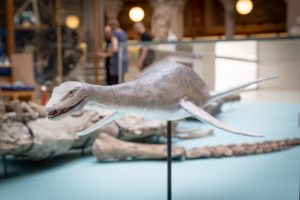Plesiosaurus Rises to the Surface
Rare Plesiosaur Fossil Discovered in Canadian Oil Sands
Engineers and equipment operators working in the large quarries that make up the Canadian Oil Sands have to keep a sharp look out for amongst the dark, blackened rocks monsters lie in wait. Canada has the largest deposits of what are known as “bituminous sands” in the world. These deposits are mixtures of sand, clay, water and other debris as well as heavy crude oil, so viscous that it does not flow like oil but tends to have the composition of treacle toffee. When refined this super, heavy crude can be turned into oil, but for palaeontologists these rocks laid down at the bottom of a Cretaceous sea also contain fossils, including the preserved remains of marine reptiles.
Rare Plesiosaurus Fossil Discovered
One nearly complete marine reptile fossil, was discovered a few days ago by one sharp-eyed digger operator whilst working on a deposit. November 14th will always be a red-letter day for operator Maggy Horvath as she discovered the remains of a plesiosaur. Plesiosaurs were a group of marine reptiles ranging in size from three metres in length to more than 12 metres long. Many were long-necked, fish eaters that swam with the aid of four large flippers. Other forms, the shorter-necked group are classed as pliosaurs, many of which were huge, apex predators in their marine environment.
The fossil is being examined by scientists at Royal Tyrrell Museum (Drumheller, Alberta) they have removed most of the specimen from the quarry.
A Plesiosaur – Large Marine Reptile
Picture credit: Everything Dinosaur.
Museum spokesperson Don Brinkman commented:
“This is a very rare find. It’s a long-necked plesiosaur, which is a marine reptile with a very long neck, small head and short body.”
The fossil was found at a Syncrude company site, a number of marine reptile fossils have been found on their oil sand deposits as Brinkman stated:
“The last one that was recovered was 10 years ago; it was recognised as a new kind and given the name Wapuskanectes.”
When she discovered the bones, operator Maggy Horvath said she immediately stopped digging and told a Syncrude geologist who works with the Royal Tyrrell on fossil discoveries.
This fossil discovery is similar to one a few years earlier. The oil sand specimen might even have part of its hide preserved.
She later added:
“It felt pretty good to call my son and let him know that I found a prehistoric fossil while working.”
Just occasionally, dinosaur fossils are found in the oil sands. Some dinosaur carcases must have floated out to see and then sank, settling on the seabed, these specimens are much rarer than the marine reptile remains.
To read an article about a rare dinosaur discovery: Ankylosaur fossil found in Oil Sands.
For models and replicas of marine reptiles including plesiosaurs: CollectA Age of Dinosaurs Figures.


